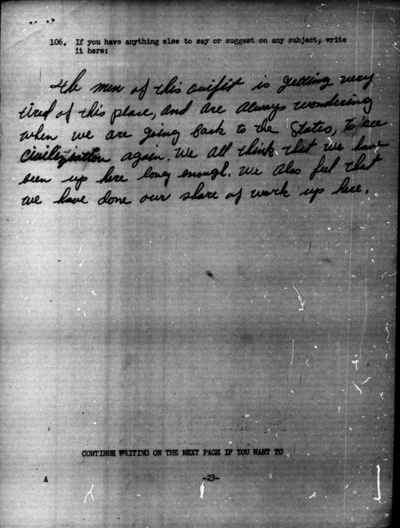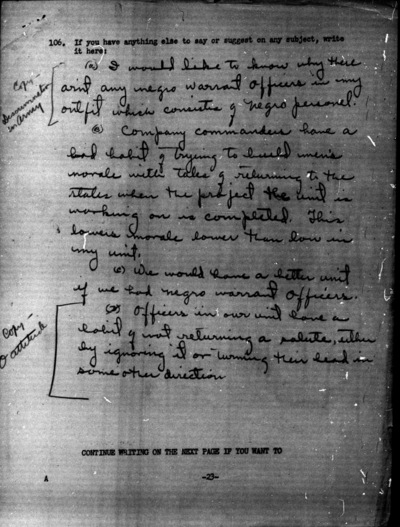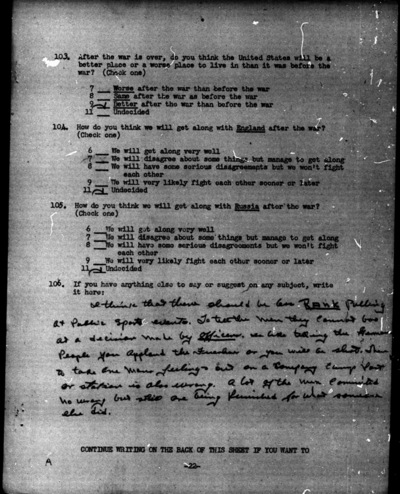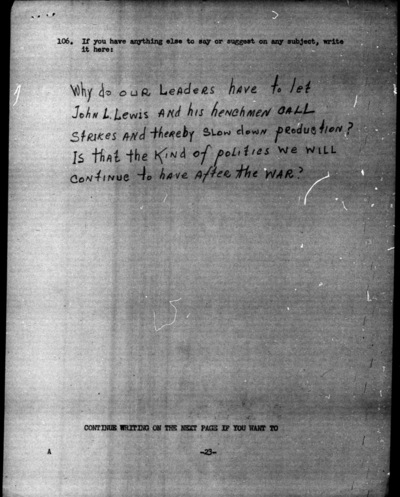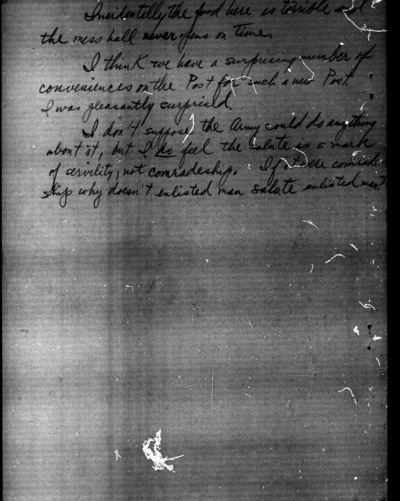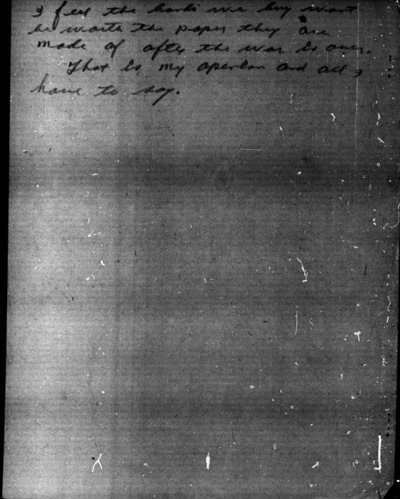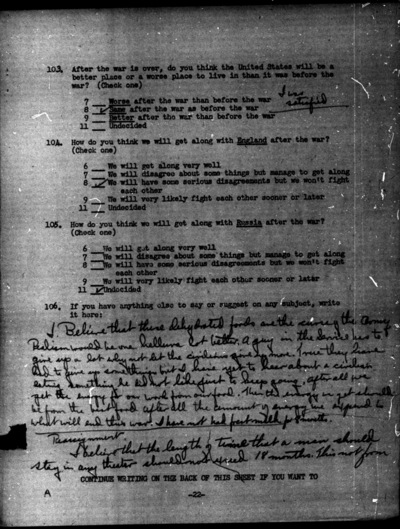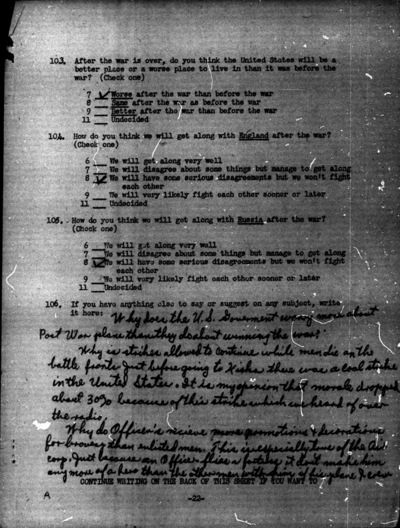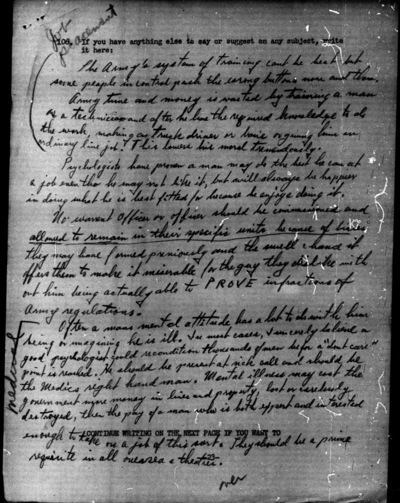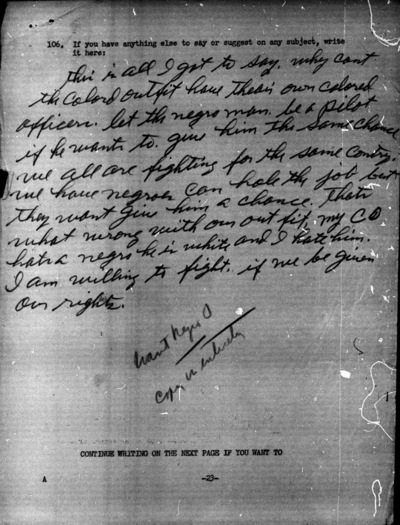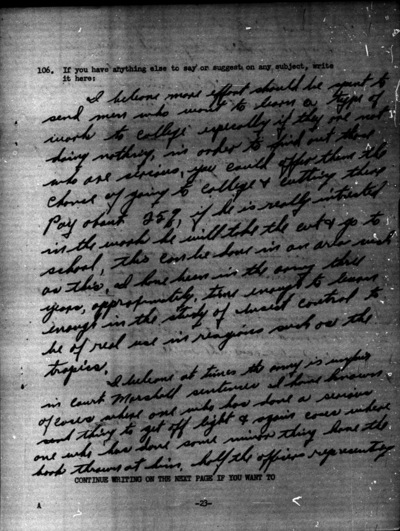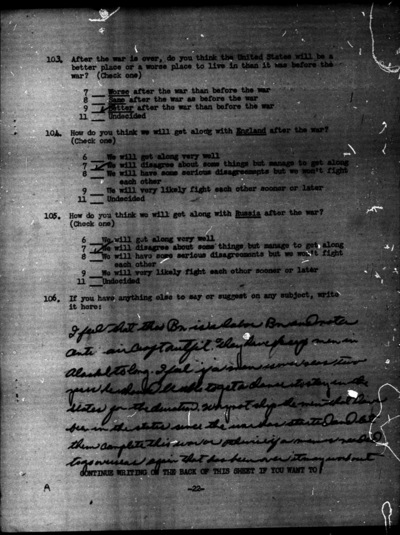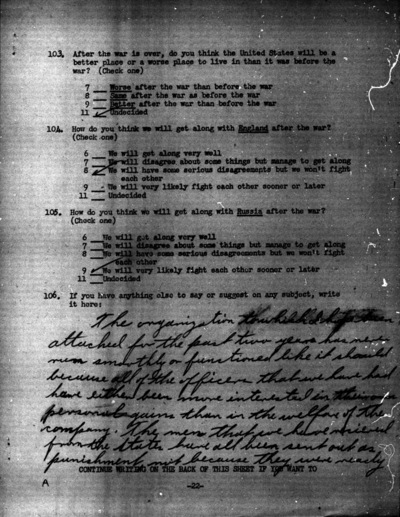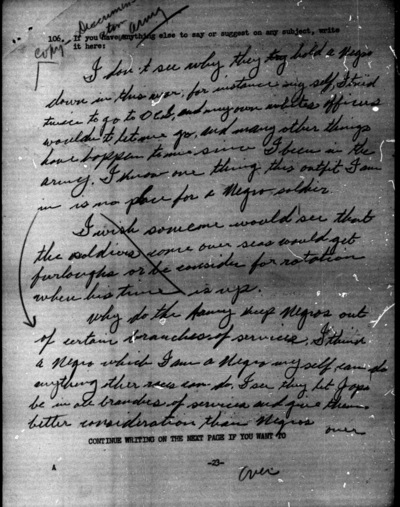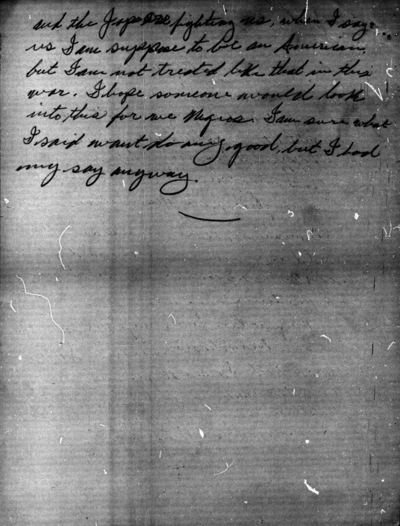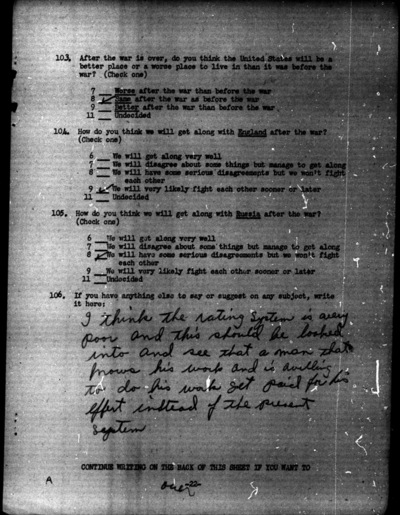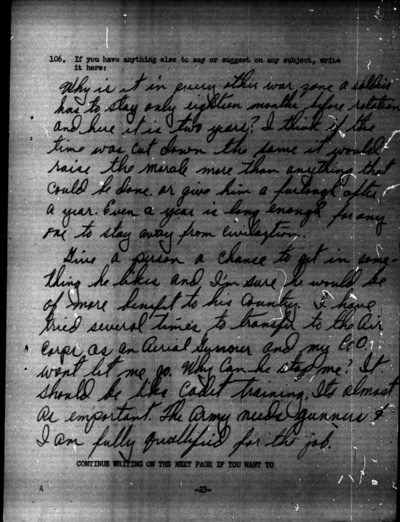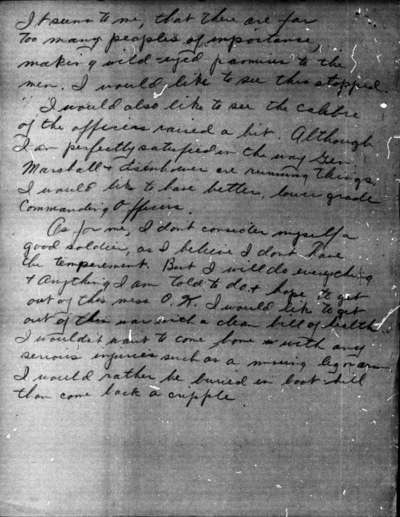S133: Alaska Department
a. Morale: items for several of the standard general adjustment scales were included for comparison with studies being done in other overseas theaters and in the United States. The AD Orientation Officer also was interested in data on the status of morale of troops in the Alaskan Department.
b. Demobilization and Compulsory Military Training: Research Branch Headquarters in Washington requested that standard questions on these areas be included in order to supply data to the Special Planning Division, WDSS, on soldiers' opinions of which should be released from the Army first and on soldiers' actions to postwar compulsory military training. The same questions were asked simultaneously in other overseas theaters and in the United States.
c. Desire for Post-war Education: A series of questions was asked on men's plans to go back to school after the war. These paralleled questions being asked at the same time in surveys among enlisted men in the United States.
d. Opinion Surveys: Three questions were asked at the request of the Commanding General, Alaskan Department to gauge men's opinions of the worthwhileness of opinion surveys.
e. Censorship: At the request of the Censor, Alaskan Department, one question was asked on whether enlisted men thought their censors discussed personal matters read in letters, and a series of questions was asked on men's use of "Blue Envelopes” and the status of regulations in their own outfits in respect to letter-writing.
f. Food: Information on men's opinions of the quality of the food at their own posts and their preferences as to kinds of foods was requested by the Quartermaster, Alaskan Department.
g. Housing: The men were asked to indicate the kinds of quarters they had lived in in the past, were living in at present, and their own preferences. Requested by the Commanding General, AD, and the Engineer, AD.
h. Employment of Civilian Workers: For the information of the Civilian Personnel Officer, AD, and the Engineer, XI Air Force Service Command, the men were asked for their opinions on the usefulness of and necessity for civilian workers at their own posts, and the status of male civilian workers in respect to the draft.
i. Orientation: The men were asked the status of orientation meetings in their own outfits, whether they understood the purpose of orientation, and topics they thought most important for discussion. Requested by the Orientation Officer, G-3, Alaskan Department.
j. Training: To find out whether the men thought they had enough training to protect themselves and what kind of training they thought they needed more of. This information was obtained for A-3, XI Air Force Service Command and G-3, Alaskan Department.
k. Health, Medical and Dental Care: To find out men's opinions of the medical and dental care they were receiving and what effect they thought the climate was having on their health. Requested by the Surgeon, XI Air Force Service Command and the Surgeon, AD.
l. Recreation. Special Services. Radio: The men were asked whether they had trouble finding interesting things to do, the extent of the effort being made to provide facilities for them, what facilities were needed, how they felt about Special Services in general, the availability of radios, the extent of listening, and AFRS program preferences. Information on these subjects was requested by the Special Service Officer, AD, and the Special Service Officer, XI Air Force Service Command.
m. Individual Pay Record Books: A supplementary page containing four questions on the usefulness of the Pay Record Book and men's habits in regard to its use were inserted in every fifth questionnaire administered in Air Forces units and every seventh administered in Ground Forces units. This information was requested by the Finance Officer, XI Air Force Service Command, the Finance Officer, Alaskan Department, and the Personnel Officer, Adjutant General Section, AD.
n. Negro Troops: The Inspector General of the War Department liras interested in securing information on the attitudes of Negro troops.
Questionnaire
Date
Original Size
Location
Theater ID
AD2A, AD2B
Alternate Title
Attitudes of Troops in Alaska
Sample Description
Ten installations were visited and approximately 90 units were sampled.
Sample Method
a. Posts with less than 500 troops were excluded as were those in south-eastern Alaska where less than 5% of the total troop strength was located.
b. Installations visited on the Alaskan Mainland were:
- Ft. Richardson - A large, garrison type post adjacent to Anchorage, a sizeable civilian community.
- Whittier - A small post, principally port activities. No civilian community adjacent, but one could be visited on a three-day pass.
- Ft. Greeley - A fairly large post with Kodiak, a small civilian community adjacent.
- Nome - A small far-north post. This was a small civilian community.
- Fairbanks - A fairly large Northern post, principally an air base. The only troops there who were under Alaskan Department jurisdiction were Infantry and a few service troops.
c. Installations visited on the Aleutians were:
- Adak - A large, well-established post.
- Attu - A large, somewhat newer post.
- Shumya - A relatively small and new post with principally Air Corps activities.
- Ft. Glenn, Umnak - One of the oldest Aleutians posts, fairly large and well established.
- Ft. Glenn, Subpost - A small post with principally port activities. Reached by a two-hour boat trip from Umnak.
- None of the Aleutian posts sampled was adjacent to any kind of civilian community and none had any women other than a handful of nurses.
Sample:
d. Cases Cross-section of white enlisted men
- Number: 1535 were administered the A-Form; 1537 were administered the B-Form
- Geographic coverage: Alaskan Mainland and the Aleutian Islands
- Special notes: Sample covers all the white troops in the Department except for a few in the ATC and Alaskan Communication System which were not under the Alaskan Department.
e. Special sample of Negro enlisted men (literates only)
- Number: 128 were administered the A-Form; 122 were administered the B-Form
- Geographic coverage: Aleutian Islands (there were no Negro troops on the Mainland)
- Special notes: Illiterates were excused and not interviewed. Size of sample largely limits use to overall tabulations.
f. Three special camp samples of white enlisted men
Number: Kodiak - 156 were administered the A-Form; 153 were administered the B-Form
Nome and Fairbanks - 100 were administered the A-Form in each camp; 100 were administered the B-Form in each camp
Geographic coverage: All three were mainland installations.
Special notes: The cross-section contains some men from each of these camp samples. Purpose of the additional cases was to get a large enough sample at each of the three camps to allow comparison of marginals. It was thought that conditions in the far North-Nome and Fairbanks - were sufficiently different to make separate study of them useful.
Scales and Scores
a. Both Forms A and B of the questionnaire:
Personal Adjustment Scale
a) Q. 16, 17; 18 in Form A; Q. 12, 13, 14 in Form B
b) Scores are on Col. 71 of both A and B cards
Job Satisfaction Scale
a) Q. 19, 20, 21, 22, 23, 24 on Form A. Q. 15, 16, 17, 18, 19, 20 on Form B
b) Scores are in Col. 72 of both A and B cards
b. Form A only:
Faith in Mission Scale
a) Q. 36, 37, 38
b) Scores are in Col. 70, A cards only
Confidence and Pride in Outfit Scale
a) Q. 40, 41, 42, 43
b) Scores are in Col. 73, A-cards only
Self-Confidence Scale
a) Q. 27, 46, 47
b) Scores are on Col. 74, A-cards only
Faith in Future Scale
a) Q. 100, 103, 104, 105
b) Scores are on Col. 75, A-cards only
Belief in the Army's concern for the Welfare of the Individual Scale
a) Q. 39, 45, 68
b) Scores are on Col. 76, A-cards only
Zeal Scale
a) Q. 93, 95, 96, 97
b) Scores are on Col. 77, A-card only
c. Form B only:
Demobilization Choices
a) Q. 51a, b, c, d, e, f.
b) Scores are on Col. 57, 58, 59, 60 of B-cards only
Postwar Desire to Settle in Alaska Scale
a) Q. 44, 45, 46, 47, 48, 49
b) Scores on Col. 70, B-cards only
Location Details
Ft. Greeley, AK
Nome, AK
Fairbanks, AK
Ft. Richardson, AK
Whittier, AK
Adak, AK
Attu, AK
Ft. Glenn, AK
Shumya, AK
Ft. Glenn, AK
Ft. Glenn, Subpost, AK
Study Analysts
Origin
Research Branch Headquarters in Washington
Reports
WHAT SOLDIERS IN ALASKA THINK . . .?
1 About Opinion Surveys
2 About Censorship
3 Food Preferences
4 About Individual Pay Records
5 Preferences in Housing
6 About Employment of Civilian Workers on Army Posts
7 About Orientation
8 About Things in General
9 Radio and Radio Programs
10 About Training
11 Attitudes of Negro Soldiers
12 About Their Health and Medical Care
13 About Recreation and Special Service
14 About Workload and Time Off
15 About Clothing and Individual Equipment
16 About the Red Cross
17 Information about Army Emergency Relief
18 About Armed Forces Institute Courses
19 About Settling in Alaska After the War
20 What Soldiers in Alaska Think (A Summary)
B-1 Introduction to a Series of Reports on “What Soldiers in Alaska Think”
B-2 Morale in the Aleutians
B-3 Summary of Significant Points from Alaskan Department Survey
B-4 Interest in Post-War Alaskan Settlement by Soldiers Serving in Alaska
WST #8 What Soldiers Think of Attitude Surveys
WST #8 Yakutsk versus Quonset
WST #9 Rotation Problems of Men in Inactive Theaters
Monthly Progress Report, Sept. 1944 Attitudes of Aleutian Troops Toward Their Own Health
